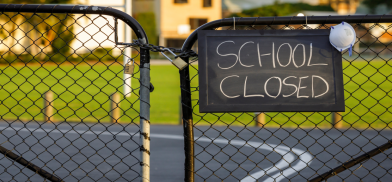South Asia and COVID-19: Impact of school closures on children’s learning
South Asia - which had the longest period of school closure - could face a learning crisis which will set us back by a decade, writes Partha Pratim Mitra for South Asia Monitor

When Covid-19 set in early 2020, the economic consequences of lockdown were an immediate concern. Next came the concerns about the impact of school closure. It was a concern for parents working from home having school-going children. Educators and policy-makers also recognised that education played a crucial role in building the social and economic potential of future citizens. The pandemic threw up new questions about children’s learning in a situation when they were unable to go to school .
The data on School Closures in the Asia and the Pacific region showed that South Asia had the longest period of school closure.
Source: UNESCO COVID-19 Response, Quoted fromAbdul Abiad, et al, Inadequate learning, loss of earnings: The staggering cost of school closures in AsiaAsian Development Bloghttps://blogs.adb.org/blog/inadequate-learning-loss-earnings-staggering-cost-school-closures-asia
Economic crisis increases school dropout
The COVID-19 pandemic through the income shock got transmitted to children’s learning. The economic contraction in 2020 led to higher unemployment and lower incomes, forcing more people into poverty. The Asian Development Bank estimates show that because of the pandemic, 162 million more people in developing Asia are living below the $3.20 a day poverty threshold.
The result is that an increasing number of households have been unable to continue supporting their children’s education. More number of children dropped out of school during the pandemic, which in turn had its impact on lowering the average learning achievement of affected countries. An estimated 506,130 more students out of 800 million pre-primary, primary and secondary school students in developing Asia dropped out of school during the pandemic in 2020.[i]
Increase in child labour as social workers handicapped
As the COVID-19 crisis heightened the risks children face, it has undercut the ability of social services to protect them and ensure their well-being. Dedicated and qualified social service workers support children and families in poverty alleviation, identifying and managing risks, and facilitating access to essential social services. Both short-term mobility restrictions and the diversion of financial and human resources to other urgent needs during the pandemic have constrained the vital work of social service workers.
This gap, in turn, made efforts to protect children, including their assistance in the enforcement and implementation of policies and laws, lax in many countries of the region resulting in the growing incidence of child labour mainly in the informal sector, where they often work as unskilled labourers. Greater informal employment coupled with economic hardship of parents could push many children out of school and into the labour market.[ii]
While the pandemic is pushing children out of the education system and into the world of work, the education sector itself is facing three major overlapping challenges: the already existing learning crisis; the direct impacts of the health crisis due to the pandemic on school closures, and the effects of the economic crisis on education due to the overall contraction of GDP .[iii]
It is therefore important to bring COVID-19 under control as soon as possible so that all students can safely return to schools for in-person learning from teachers. Rapid implementation of nationwide vaccination programmes, alongside containment measures based on evidence of the regional intensity of the spread of the pandemic, would make a big difference for students in normalising the situation.[iv]
Adverse impact of school closure
During this past year, quite a lot of information has also been generated about learning losses caused by the lack of face-to-face classes, an unprecedented situation which the pandemic has brought about. There is theoretical evidence to suggest significant losses, particularly among disadvantaged students. The World Bank estimates that in low- and middle-income countries, the percentage of children not able to read by age 10 (the Bank’s Learning Poverty indicator) will increase by 10 points, from 53 percent before COVID-19 to 63 percent. Primary school students in developed countries such as in Belgium, the UK and the Netherlands show learning outcomes post-pandemic that are significantly lower, and that this negative effect is highly concentrated among low-income students.
The loss of learning is evident only after a few months of school closures in a high-income context where most students have access to a learning device and to the internet to follow online learning. There is every reason to believe that something similar has happened in environments where closures have been longer such as in South Asia[v]
Some important areas of children’s learning abilities are foundational reading and numeracy skills which are the building blocks for future progress, both in school and beyond. The collective experience of the PAL Network over the past 15 years demonstrates that children who fail to acquire these foundational skills in the early grades progressively fall as they continue in the education system with few opportunities to catch up later on.
The People's Action for Learning (PAL) Network was formally established in 2015 as a South-South partnership of organisations which engage in regular citizen-led assessments (CLAs) of children's foundational reading and numeracy. These assessments offer a method for assessing learning outcomes that is grounded in the realities of South Asia .[vi] There is apprehension that due to COVID-19 such assessments would face difficulties and children’s learning abilities would further get affected.
Adverse effect on girl education
Associated with PAL is the ICAN (International Common Assessment of Numeracy) - an open-source, robust and easy-to-use assessment tool, available in 11 languages, that offers international comparability of results aligned to SDG 4.1.1 (a). ICAN was developed through a joint effort among PAL Network member organisations in 13 low and middle-income countries across Africa, America and Asia.
Until recently, education of girls was not given much priority in most South Asian countries. Cultural norms in many of these countries played a significant role in access and continuation of schooling among girls. Even today, although the enrolment rates of girls have shown significant increase, many of them drop out without completing school. It is therefore likely that the mothers of many children who currently attend school have themselves either dropped out or never attended school. This is evident in the current ICAN data.[vii].The current pandemic, which has disrupted the physical attending of schools by children and the economic hardships faced by households, could further strengthen the cultural rigidities that prevent girls from attending school.
Learning poverty may go up
In October, 2019, the World Bank and UNESCO Institute for Statistics (UIS) launched an indicator of learning poverty, based on the concept that every child should be in school and must be able to read an age-appropriate text by the age of 10 years reflecting the objective of the UN Sustainable Development Goal (SDG) 4 that all children must be in school and learning.
COVID-19-related school closures over seven months in many countries could increase the learning poverty rate in the low- and middle-income countries by 10 percentage points, from 53 percent to 63 percent, it implies that an additional 72 million primary-school-age children could fall into learning poverty, of a population of 720 million children of primary-school age. • Most of the potential increase in learning poverty would take place in regions with a high but still average level of learning poverty in the global context pre-COVID-19, such as South Asia (which had a 63 percent pre-pandemic rate of learning poverty), Latin America (48 percent), and East Asia and the Pacific (21 percent).[viii].
The good news is there are solutions and a way forward that could turn this crisis into an opportunity, but only if all stakeholders act together with urgency. Otherwise, South Asia - which had the longest period of school closure - could face a learning crisis which will set us back by a decade. By creating a common vision for action and supporting each other’s efforts, we can achieve the critical change that is desperately needed[ix].
All countries of the region must come together to set a common goal and an action programme combining the strengths of each one of them to overcome the weaknesses.
(The writer is a retired Indian Economic Service officer who worked in the labour ministry. The views expressed are personal. He can be contacted at ppmitra56@gmail.com)
[i] LEARNING AND EARNING APRIL 2021 Special Topic of the Asian Development Outlook 2021 LOSSES FROM COVID-19 SCHOOL CLOSURES IN DEVELOPING ASIA1 Special Topic of the Asian Development Outlook 2021APRIL 2021https://www.adb.org/sites/default/files/publication/692111/ado2021-special-topic.pdf
[ii] COVID-19 AND CHILD LABOUR: A TIME OF CRISIS, A TIME TO ACT©2020 International Labour Organization and United Nations Children’s Fundhttps://www.unicef.org/sites/default/files/2020-06/COVID-19-and-Child-labour-2020.pdf
[iii] SAVE OUR FUTURE Averting an Education Catastrophe for the World’s Children ,LEGO Foundation. https://saveourfuture.world/wp-content/uploads/2020/10/Averting-an-Education-Catastrophe-for-the-Worlds-Children_SOF_White-Paper.pdf
[iv] Abdul Abiad,et al,Inadequate learning, loss of earnings: The staggering cost of school closures in AsiaThis blog post was based on research conducted for a special section of the 2021 Asian Development Outlook.
28 April 2021https://blogs.adb.org/blog/inadequate-learning-loss-earnings-staggering-cost-school-closures-asia
[v]Rafael de Hoyos,.et al It is time to return to learning ,7-4-2021https://palnetwork.org/it-is-time-to-return-to-learning/
[vi]ICAN International Common Assessment of Numeracy Background, Features and Large-scale Implementation, https://palnetwork.org/wp-content/uploads/2020/07/2020_PAL-Network_ICAN-Report_EN.pdf
[vii]Steffi Elizabeth Thomas, et al South Asia’s progress in tracking basic numeracy with a new assessment
9 September 2020 GEM Report https://gemreportunesco.wordpress.com/2020/09/09/south-asias-progress-in-tracking-basic-numeracy-with-a-new-assessment
[viii]João Pedro Azevedo,Learning Poverty: Measures and Simulations* Policy Research Working Paper 9446Policy Research Working Paper 9446ducation Global Practice October 2020 ,http://documents1.worldbank.org/curated/en/232501603286799234/pdf/Learning-Poverty-Measures-and-Simulations.pdf
[ix] SAVE OUR FUTURE Averting an Education Catastrophe for the World’s Children ,LEGO Foundation. https://saveourfuture.world/wp-content/uploads/2020/10/Averting-an-Education-Catastrophe-for-the-Worlds-Children_SOF_White-Paper.pdf











Post a Comment